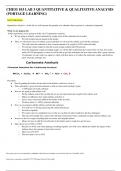Exam (elaborations)
CHEM 103 LAB 3 QUANTITATIVE & QUALITATIVE ANALYSIS (PORTAGE LEARNING)
- Course
- Institution
CHEM 103 LAB 3 QUANTITATIVE & QUALITATIVE ANALYSIS (PORTAGE LEARNING)/CHEM 103 LAB 3 QUANTITATIVE & QUALITATIVE ANALYSIS (PORTAGE LEARNING)/CHEM 103 LAB 3 QUANTITATIVE & QUALITATIVE ANALYSIS (PORTAGE LEARNING)
[Show more]



